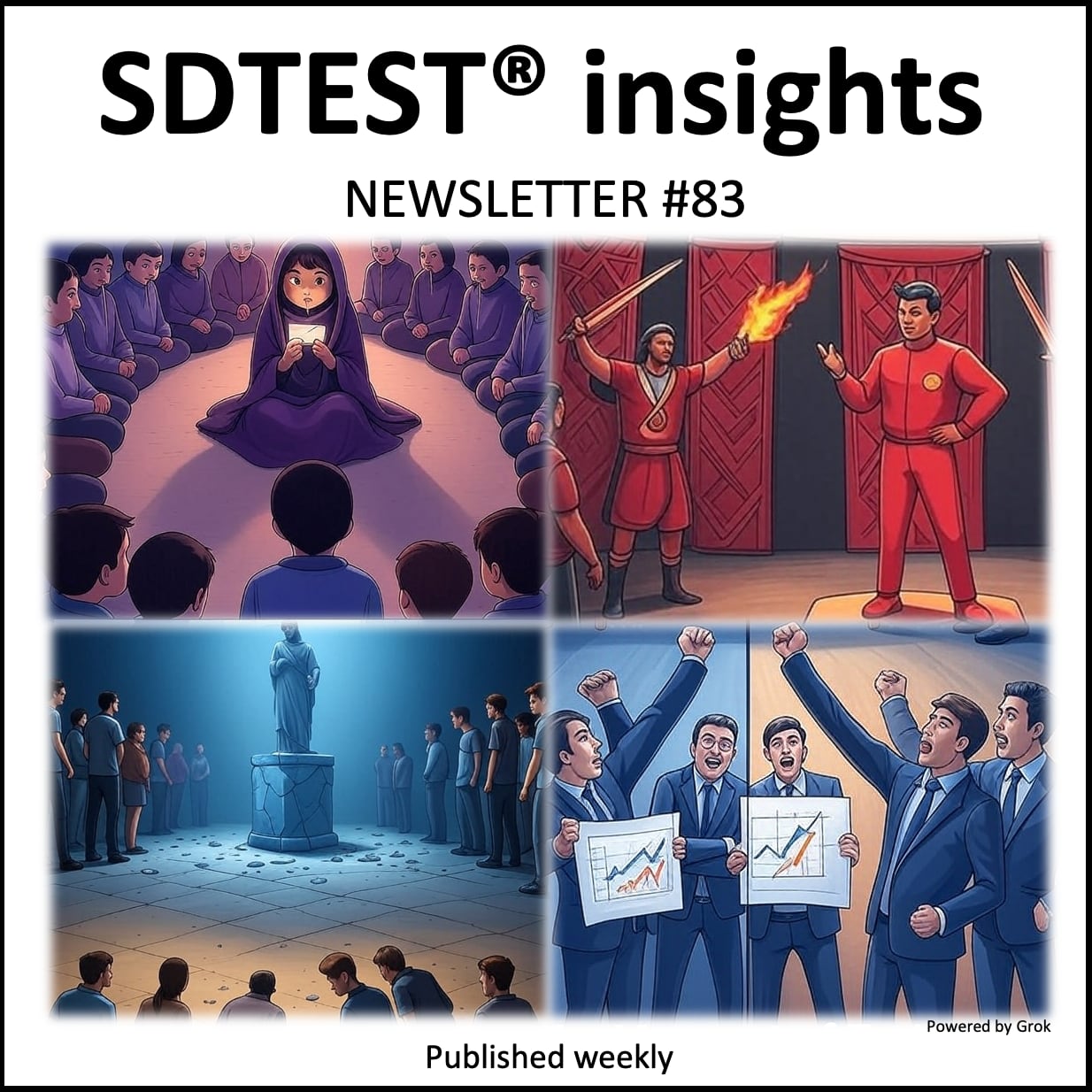SDTEST® has 38 different VUCA polls that calculate the 13,643 correlation values between stages of development according to the theory of Spiral Dynamics and answer options of these 38 polls.
We invite curiosity about the systemic mechanisms behind this correlation. There may be hidden variables that provide alternative explanations.
In our analysis of the poll "12 ways to build trust with others" (by Justin Wright [1]), we found an intriguing negative linear correlation that warrants closer examination:
-0.1319 (Pearson) between the Keep private information confidential (Respecting secrets earns respect in return) / Agree strongly and the Purple stage.
The critical value of the correlation coefficient for a normal distribution, by William Sealy Gosset (Student), is r = 0.1152. Nevertheless, this negative linear correlation of -0.1319 meets the reliability criteria but does not necessarily imply causation.
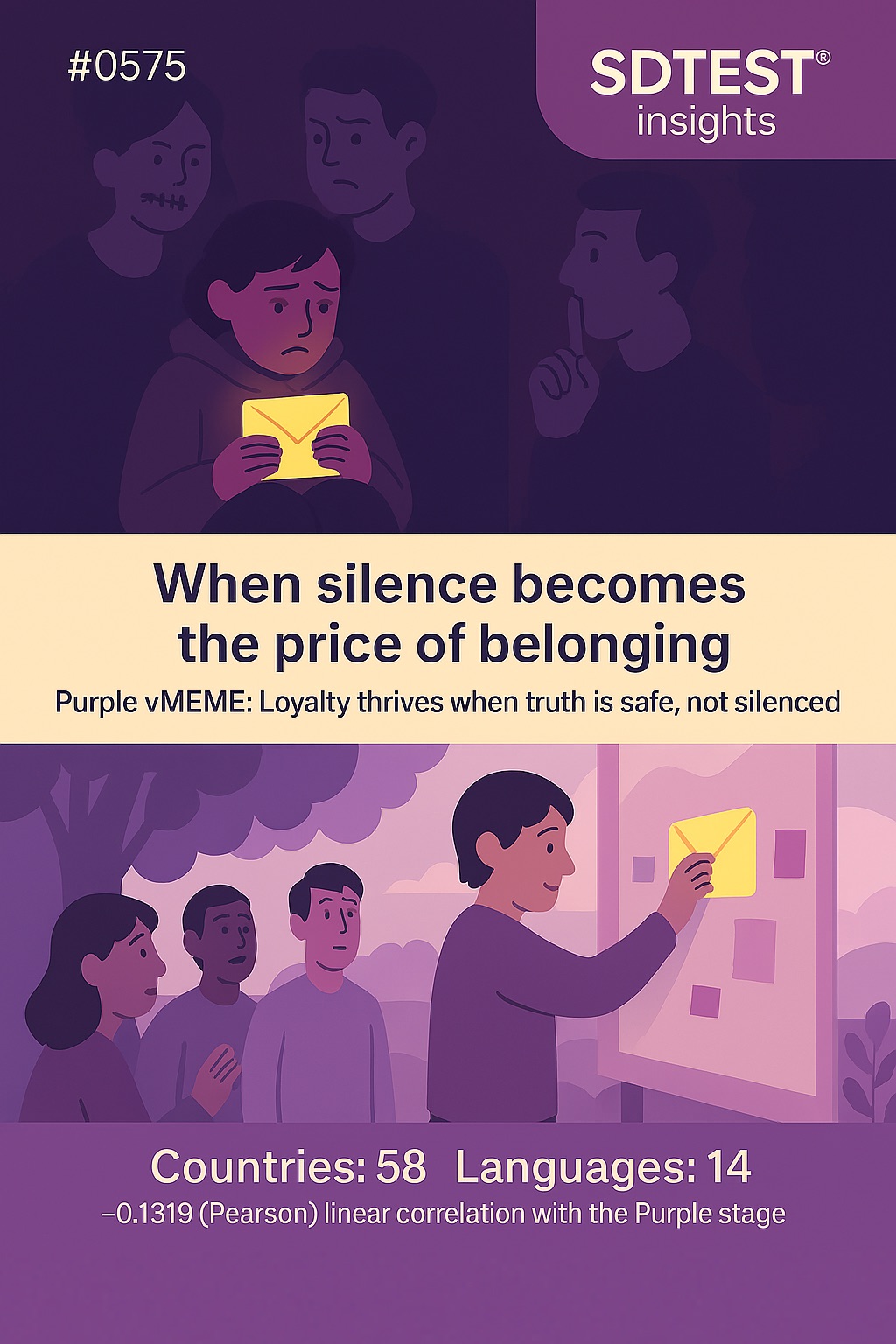
This negative correlation of -0.1319 between "Keep private information confidential (Respecting secrets earns respect in return) / Agree strongly" and the Purple stage offers intriguing insights when viewed through the lens of the Purple value system:
Organizational Perspective:
Organizations operating within the Purple mindset might interpret this correlation as:
- Validation of their ancestral wisdom-based approach, where information sharing follows sacred customs and tribal protocols rather than individual confidentiality concepts
- Confirmation that their spiritual leader-centered structure requires transparent communication channels where the chief or shaman must know all tribal matters for proper guidance
- Evidence supporting their belief that collective survival depends on communal knowledge sharing and that withholding information threatens the spiritual protection of the entire group
These organizations might respond by:
- Implementing traditional council systems where all significant information flows through spiritual leaders and elders who hold sacred responsibility for tribal welfare
- Establishing ritual information-sharing ceremonies where knowledge is collectively processed through ancestral wisdom and divine guidance
- Creating communal decision-making processes where individual secrets are seen as potential threats to group harmony and spiritual protection
Team Perspective:
Teams operating from a Purple mindset might approach this correlation by:
- Viewing it as an affirmation of their tribal unity approach, where collective survival requires open sharing within the sacred circle of team members
- Interpreting it as support for their belief that maintaining secrets disrupts the spiritual bonds and ancestral protection that keep the team safe
- Seeing it as validation for prioritizing communal knowledge and collective wisdom over individual privacy, which might weaken tribal cohesion
These teams might respond by:
- Conducting regular sharing rituals where team members openly discuss challenges and information to maintain spiritual harmony
- Encouraging collective problem-solving through ancestral wisdom and group consultation rather than individual confidentiality practices
- Celebrating instances where open communication strengthens tribal bonds and invites protective spiritual forces to guide team decisions
Individual Perspective:
Individuals aligned with the Purple value system might interpret this correlation as:
- Personal validation of their communal identity, where loyalty to the tribe requires sharing important information with spiritual leaders and trusted elders
- Evidence supporting their belief that keeping secrets from the community violates ancestral customs and may invite spiritual punishment or tribal rejection
- Confirmation of the value they place on collective wisdom and their understanding that individual secrets threaten the sacred bonds that provide protection
These individuals might respond by:
- Actively seeking guidance from spiritual leaders and sharing personal concerns to maintain a proper relationship with ancestral forces
- Viewing confidentiality as potentially selfish behavior that prioritizes individual interests over tribal welfare and spiritual harmony
- Using traditional disclosure practices and ritual confession to ensure they remain in good standing with protective spirits and community elders
This correlation, viewed through the Purple lens, suggests that those operating at the Purple level are less likely to strongly agree that keeping private information confidential builds trust. It implies that the Purple value system's emphasis on communal identity, spiritual protection, and ancestral wisdom creates different trust-building mechanisms based on transparency within sacred relationships.
The reasons why keeping private information confidential might not be seen as a trust-building method in the Purple stage could include:
- Tribal Transparency: Trust is built through open sharing within the sacred community rather than individual confidentiality that may hide threats
- Spiritual Protection: The spiritual leader and elders must know all information to provide proper guidance and invoke ancestral protection for the group
- Collective Survival: Community welfare requires shared knowledge so the tribe can respond collectively to dangers and opportunities
- Sacred Bonds: Trust flows from ritual participation and communal identity rather than from individual promises of secrecy
- Ancestral Wisdom: Traditional customs emphasize collective decision-making and elder guidance over individual confidentiality practices
This correlation prompts us to consider how different value systems influence trust-building approaches and information sharing behaviors. It raises questions about the potential conflicts between individual privacy concepts and communal transparency requirements, particularly in contexts where spiritual protection and tribal cohesion are fundamental to group survival.
Ultimately, this correlation highlights the complex interplay between cultural values, trust mechanisms, and information sharing practices. Confidentiality might be seen not as a trust-building tool but as potentially harmful behavior that disrupts spiritual harmony and weakens the sacred bonds essential for Purple-dominant environments.
In our analysis of the poll "The main priorities of job seekers," we found an intriguing negative linear correlation that warrants closer examination:
-0.3776 (Pearson) between the Appreciation for the work done and the Red stage (Germany, German).
The critical value of the correlation coefficient for a non-normal distribution, by Spearman, is r = 0.0854. Nevertheless, this negative linear correlation of -0.3776 meets the reliability criteria but does not necessarily imply causation.
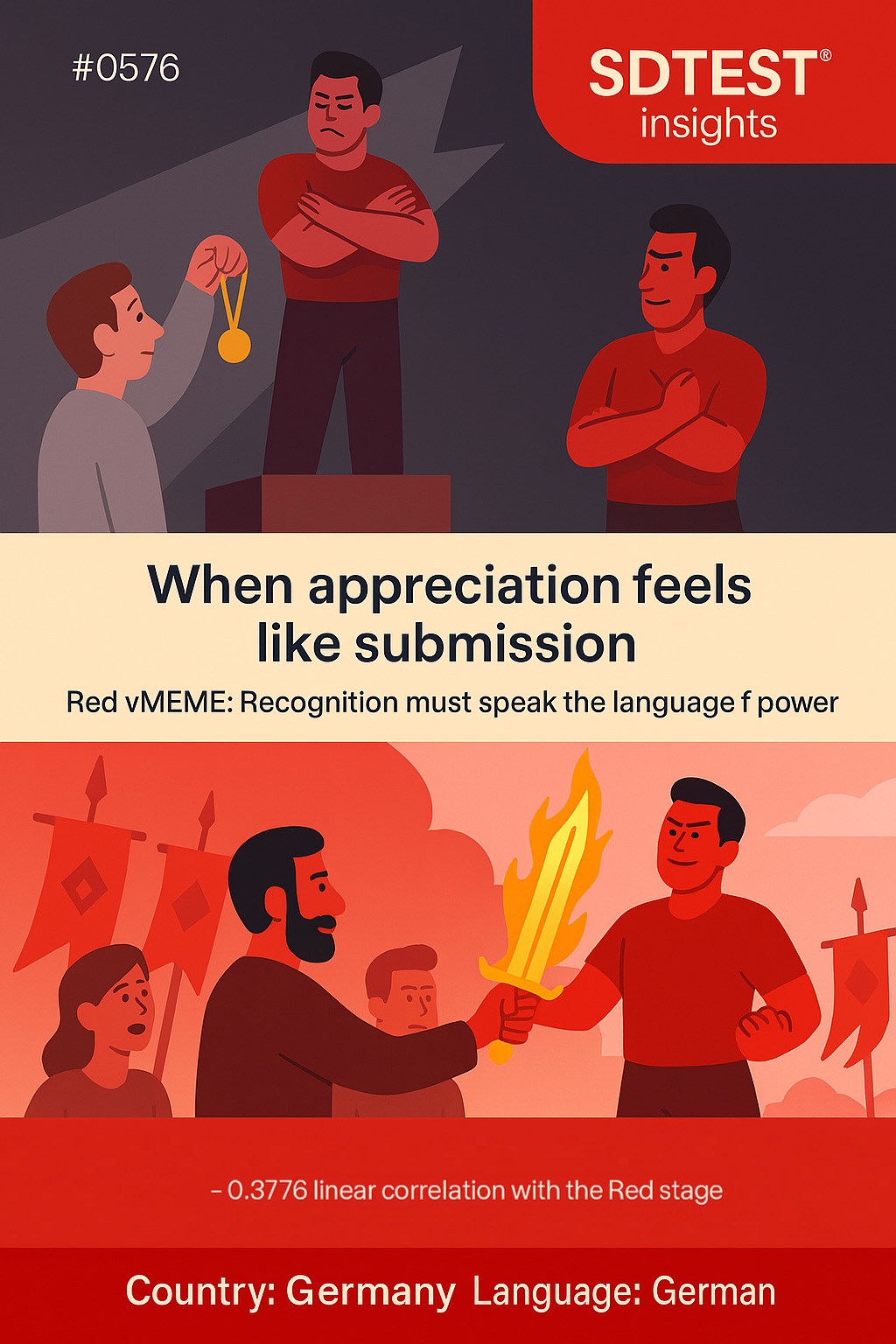
This negative correlation of -0.3776 between "Appreciation for the work done" and the Red stage (Germany, German) offers intriguing insights when viewed through the lens of the Red value system:
Organizational Perspective:
Organizations operating within the Red mindset might interpret this correlation as:
- Validation of their power-driven, results-focused approach, where tangible rewards and immediate benefits matter more than abstract appreciation or recognition
- Confirmation that their dominance-based hierarchy systems prioritize concrete compensation and advancement opportunities over emotional validation
- Evidence supporting their belief that strong performers demand real power, territory, and resources rather than superficial praise or acknowledgment
These organizations might respond by:
- Implementing aggressive compensation structures with immediate bonuses and territorial rewards that demonstrate actual power rather than offering ceremonial appreciation
- Establishing competitive advancement systems where superior performers gain real authority and control over resources and people
- Creating winner-takes-all environments where dominance is rewarded with tangible benefits while eliminating time-wasting appreciation ceremonies
Team Perspective:
Teams operating from a Red mindset might approach this correlation by:
- Viewing it as an affirmation of their competitive, power-focused dynamic, where team members seek concrete advantages and territorial gains over appreciation
- Interpreting it as support for their belief that strong performers want immediate gratification and real rewards rather than empty praise or recognition rituals
- Seeing it as validation for prioritizing individual dominance and personal advancement over collective appreciation or team harmony
These teams might respond by:
- Engaging in direct competition for resources, territory, and leadership positions rather than participating in appreciation-based team building
- Encouraging team members to assert their dominance and claim credit for victories while dismissing appreciation as weakness
- Celebrating instances where individuals successfully grab power, resources, or advancement opportunities through forceful self-promotion
Individual Perspective:
Individuals aligned with the Red value system might interpret this correlation as:
- Personal validation of their aggressive, self-centered approach, where they demand real compensation and power rather than symbolic appreciation
- Evidence supporting their belief that showing strength means rejecting soft rewards and demanding tangible benefits that demonstrate their dominance
- Confirmation of the value they place on immediate gratification and their disdain for abstract recognition that doesn't provide concrete advantages
These individuals might respond by:
- Actively rejecting appreciation-based rewards and aggressively negotiating for real money, power, and territorial control
- Viewing their dismissal of appreciation as a demonstration of their strength and their focus on what truly matters
- Using their rejection of soft rewards to assert dominance and show that they cannot be satisfied with empty gestures
This correlation, viewed through the Red lens, suggests that those operating at the Red level in Germany are less likely to prioritize appreciation for work done as a job-seeking priority. It implies that the Red value system's emphasis on power, immediate gratification, and tangible rewards creates disdain for abstract appreciation that doesn't translate into concrete benefits.
The reasons why appreciation for work done might not be needed in the Red stage could include:
- Tangible Rewards: Red demands immediate, concrete benefits like money, power, and territory rather than abstract appreciation or recognition
- Dominance Display: Seeking appreciation is viewed as weakness; strong individuals take what they deserve without needing validation from others
- Power Focus: Real success means gaining actual control and authority, not receiving ceremonial praise or symbolic acknowledgment
- Immediate Gratification: Appreciation doesn't provide instant satisfaction; Red prefers rewards that can be enjoyed immediately and concretely
- Competitive Advantage: Time spent on appreciation rituals could be better used in asserting dominance and claiming superior positions
This correlation prompts us to consider how different value systems influence workplace motivation and reward preferences. It raises questions about the potential disconnect between traditional appreciation-based management approaches and power-driven individuals, particularly in contexts where aggressive competition and immediate gratification are prioritized.
Ultimately, this correlation highlights the complex interplay between cultural values, individual motivation, and reward systems. Appreciation for work done might be seen not as a desirable job priority but as a distraction from pursuing real power and tangible benefits in Red-dominant environments.
In our analysis of the poll "Trust" (by WVS) [Could you tell us how much confidence you have in organizations?], we found an intriguing negative linear correlation that warrants closer examination:
-0.1069 (Pearson) between the Charitable or humanitarian organizations / A great deal and the Blue stage.
The critical value of the correlation coefficient for a normal distribution, by William Sealy Gosset (Student), is r = 0.0596. Nevertheless, this negative linear correlation of -0.1069 meets the reliability criteria but does not necessarily imply causation.
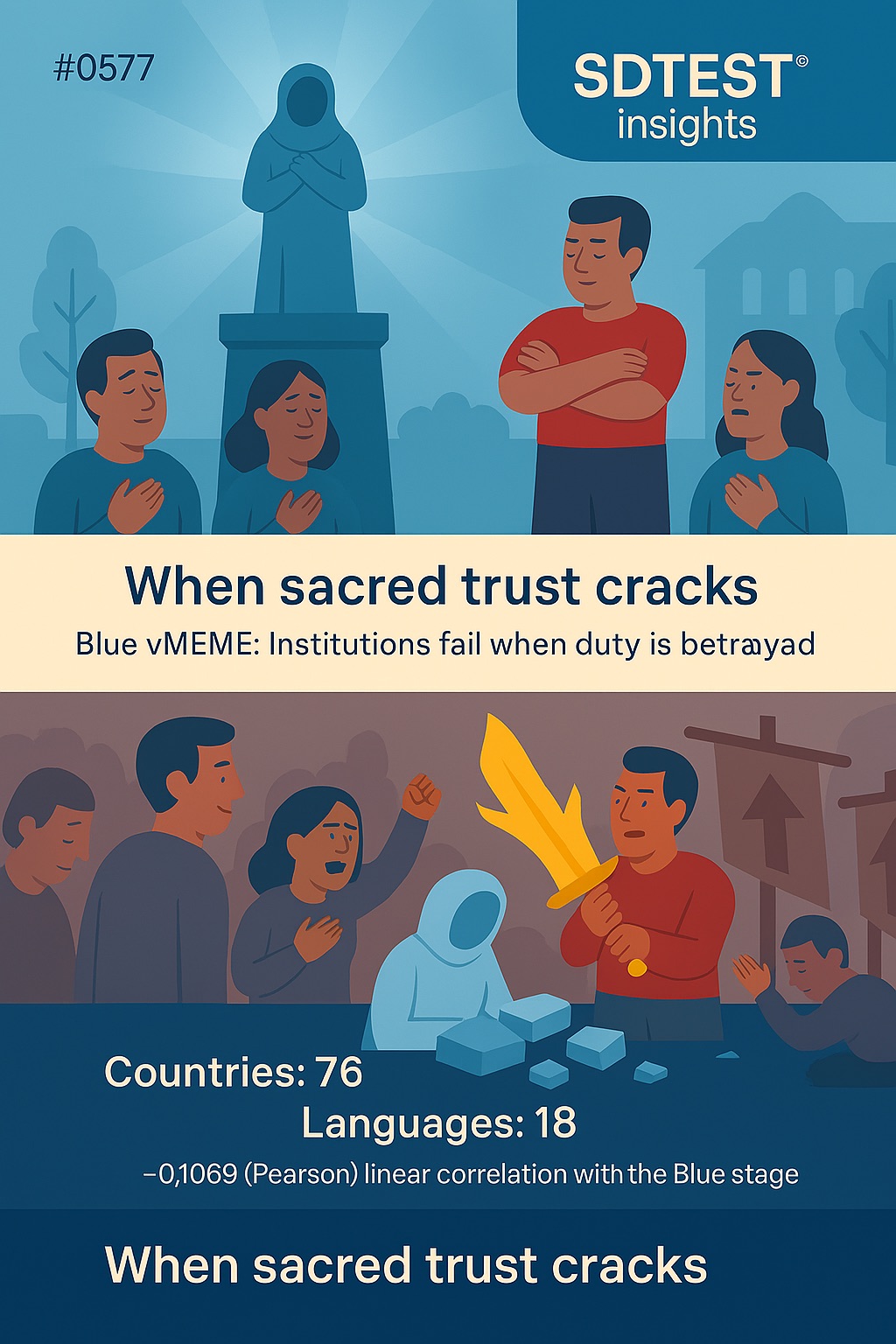
This negative correlation of -0.1069 between "Charitable or humanitarian organizations / A great deal" and the Blue stage offers intriguing insights when viewed through the lens of the Blue value system:
Organizational Perspective:
Organizations operating within the Blue mindset might interpret this correlation as:
- Validation of their institutional hierarchy approach, where charitable work should flow through established religious, governmental, or traditional authority structures rather than independent humanitarian organizations
- Confirmation that their moral code-based system prioritizes organized charity through proper channels like churches, the military, and state institutions that maintain divine or constitutional authority
- Evidence supporting their belief that legitimate humanitarian efforts must align with traditional moral frameworks and established institutional oversight rather than operating as autonomous entities
These organizations might respond by:
- Implementing charitable programs through established religious denominations, government agencies, or military service organizations that maintain proper moral authority
- Establishing clear protocols that direct charitable giving through institutional channels with proven track records and traditional oversight mechanisms
- Creating structured volunteer programs that operate within established hierarchical frameworks under the guidance of recognized moral authorities
Team Perspective:
Teams operating from a Blue mindset might approach this correlation by:
- Viewing it as an affirmation of their duty-bound approach, where charitable obligations should be fulfilled through established institutions rather than independent humanitarian groups
- Interpreting it as support for their belief that proper charitable work follows traditional protocols and institutional guidance rather than unregulated humanitarian initiatives
- Seeing it as validation for prioritizing institutional loyalty and structured giving over potentially unaccountable humanitarian organizations that lack proper oversight
These teams might respond by:
- Organizing collective charitable activities through established religious institutions, military veterans' organizations, or government-sanctioned programs
- Encouraging team members to fulfill their charitable duties through traditional channels that maintain proper moral authority and institutional accountability
- Celebrating instances where team members demonstrate charitable responsibility through established organizations with proven leadership and moral oversight
Individual Perspective:
Individuals aligned with the Blue value system might interpret this correlation as:
- Personal validation of their disciplined approach to charitable giving through established religious institutions and traditional moral authorities
- Evidence supporting their belief that proper humanitarian work should be guided by time-tested institutions with moral authority rather than independent organizations
- Confirmation of the value they place on institutional accountability and their preference for charitable work that aligns with traditional moral codes
These individuals might respond by:
- Actively directing their charitable contributions through established religious organizations, military charities, or government programs with proper oversight
- Viewing their preference for institutional charity as a demonstration of moral discipline and proper stewardship of resources
- Using traditional charitable frameworks guided by religious leaders or established authorities rather than relying on independent humanitarian organizations
This correlation, viewed through the Blue lens, suggests that those operating at the Blue level are less likely to have "a great deal" of confidence in charitable or humanitarian organizations. It implies that the Blue value system's emphasis on institutional authority, moral oversight, and traditional structures creates skepticism toward independent humanitarian organizations that may lack proper institutional guidance.
The reasons why charitable or humanitarian organizations might not receive "a great deal" of confidence in the Blue stage could include:
- Institutional Authority: Confidence is reserved for established institutions with proper moral authority rather than independent humanitarian organizations
- Moral Oversight: Traditional organizations with religious or governmental oversight are trusted more than autonomous charitable entities that may lack proper guidance
- Accountability Concerns: Established institutions provide clearer accountability structures compared to independent humanitarian organizations, with potentially unclear leadership
- Traditional Channels: Charitable work should flow through time-tested institutional frameworks rather than newer humanitarian organizations without proven track records
- Proper Stewardship: Resources should be entrusted to institutions with established moral codes and hierarchical oversight rather than independent organizations
This correlation prompts us to consider how different value systems influence trust in charitable organizations and humanitarian institutions. It raises questions about the potential tensions between institutional charity and independent humanitarian work, particularly in contexts where moral authority and traditional oversight are highly valued.
Ultimately, this correlation highlights the complex interplay between institutional trust, moral authority, and charitable confidence. Independent humanitarian organizations may be viewed not as inherently untrustworthy, but as potentially lacking the institutional oversight and moral authority necessary for complete confidence in Blue-dominant environments.
In our analysis of the poll "The Five Dysfunctions of a Team" (by Patrick Lencioni [2]), we found an intriguing negative linear correlation that warrants closer examination:
-0.1714 (Pearson) between the Absence of Trust (Without trust, teams cannot function at their optimum. Trust isn't just about believing in skills; it's about vulnerability-based trust) and the Orange stage.
The critical value of the correlation coefficient for a normal distribution, by William Sealy Gosset (Student), is r = 0.1158. Nevertheless, this negative linear correlation of -0.1714 meets the reliability criteria but does not necessarily imply causation.
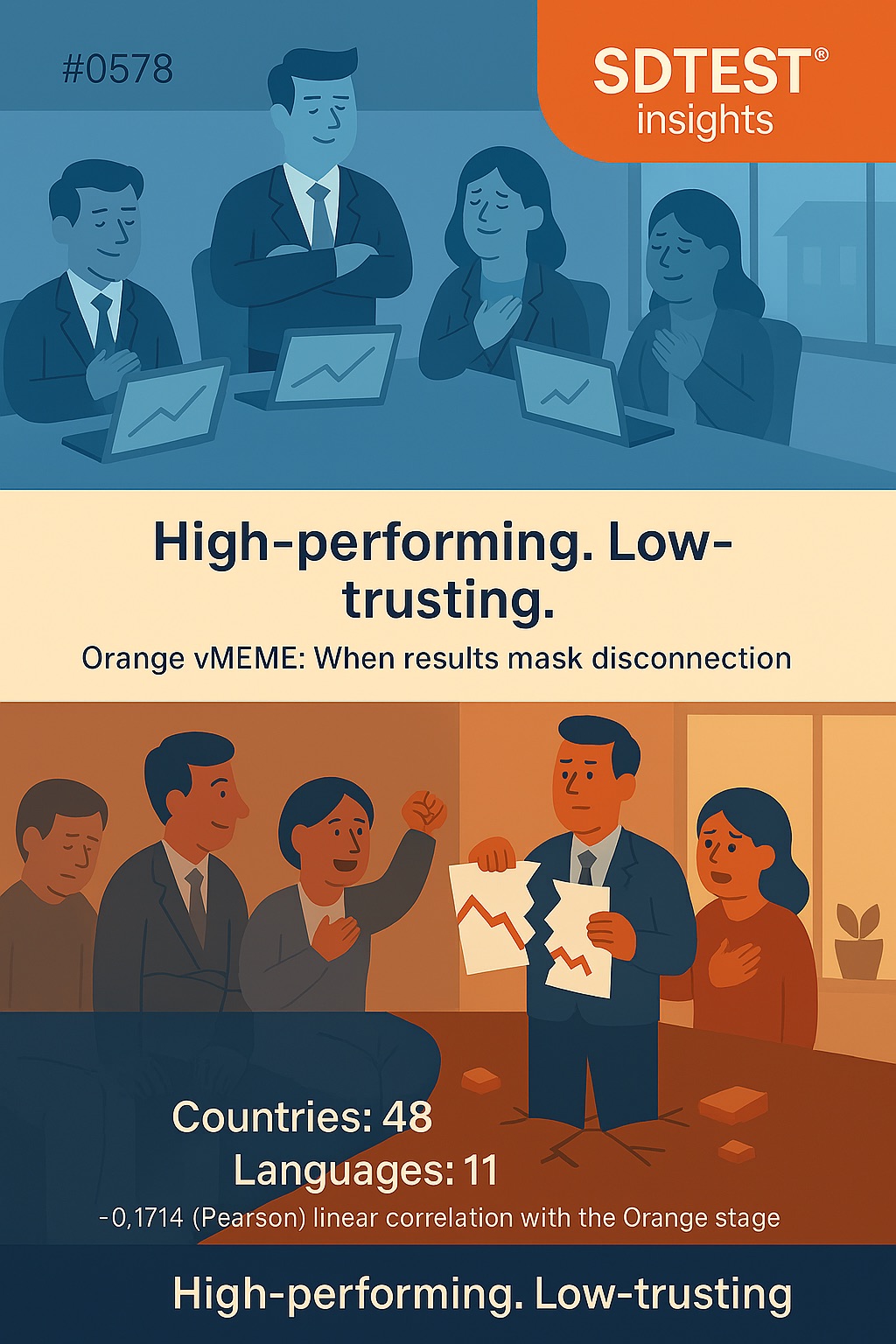
This negative correlation of -0.1714 between "Absence of Trust (Without trust, teams cannot function at their optimum. Trust isn't just about believing in skills; it's about vulnerability-based trust)" and the Orange stage offers compelling insights when viewed through the lens of the Orange value system:
Organizational Perspective:
Organizations operating within the Orange mindset might interpret this correlation as:
- Validation of their performance-driven, results-focused approach, where measurable competencies and systematic processes eliminate the need for vulnerability-based trust relationships
- Confirmation that their rational, data-driven management systems create transparent accountability structures that make emotional trust concepts unnecessary for optimal functioning
- Evidence supporting their belief that scientific methodologies and objective performance metrics provide more reliable team coordination than subjective trust dynamics
These organizations might respond by:
- Implementing comprehensive performance management systems with clear KPIs, dashboards, and objective measurements that replace trust with verifiable data
- Establishing rational decision-making frameworks based on evidence and logic rather than relying on interpersonal trust for team effectiveness
- Creating efficient organizational structures with defined roles, responsibilities, and processes that optimize performance through systematic design rather than emotional bonding
Team Perspective:
Teams operating from an Orange mindset might approach this correlation by:
- Viewing it as an affirmation of their competency-based, achievement-oriented approach, where professional capability and measurable results matter more than vulnerability-based relationships
- Interpreting it as support for their belief that rational collaboration and clear performance standards create effective teamwork without requiring emotional trust
- Seeing it as validation for prioritizing individual expertise, competitive excellence, and systematic processes over subjective trust-building activities
These teams might respond by:
- Developing data-driven collaboration methods with clear metrics, defined deliverables, and objective assessment criteria that ensure team effectiveness
- Implementing agile methodologies and project management systems that coordinate team efforts through rational processes rather than trust relationships
- Celebrating instances where team members deliver exceptional results through professional competence and systematic execution rather than personal bonding
Individual Perspective:
Individuals aligned with the Orange value system might interpret this correlation as:
- Personal validation of their rational, achievement-focused approach, where professional competence and measurable contributions matter more than vulnerability-based relationships
- Evidence supporting their belief that individual excellence and logical decision-making create team value without requiring emotional openness or trust
- Confirmation of the value they place on competitive performance and their ability to succeed through merit and systematic thinking rather than interpersonal dynamics
These individuals might respond by:
- Actively focusing on skill development, performance optimization, and measurable achievements that demonstrate their professional value to teams
- Viewing their success through the lens of rational contribution and objective results rather than through emotional trust or vulnerability sharing
- Using data analysis and logical problem-solving to add team value while maintaining professional boundaries and competitive independence
This correlation, viewed through the Orange lens, suggests that those operating at the Orange level are less likely to view the absence of trust as a team dysfunction. It implies that the Orange value system's emphasis on rational thinking, measurable performance, and systematic processes creates alternative coordination mechanisms that transcend traditional trust-based team dynamics.
The reasons why the absence of trust might not be seen as a team dysfunction in the Orange stage could include:
- Systematic Coordination: Rational processes, clear metrics, and defined procedures provide more reliable team coordination than emotional trust relationships
- Performance Focus: Individual competence and measurable results create team effectiveness without requiring vulnerability-based interpersonal connections
- Data-Driven Decisions: Objective information and evidence-based analysis eliminate the need for trust-based decision-making in team environments
- Professional Boundaries: Competitive excellence and individual achievement are maintained through professional distance rather than emotional vulnerability
- Efficiency Optimization: Systematic methodologies and technological tools provide superior team coordination compared to time-intensive trust-building activities
This correlation prompts us to consider how different value systems influence conceptions of team effectiveness and interpersonal dynamics. It raises questions about the potential for rational, performance-based coordination mechanisms to replace traditional trust-building approaches, particularly in contexts where measurable results and systematic efficiency are prioritized.
Ultimately, this correlation highlights the complex interplay between rational thinking, individual achievement, and team coordination. Trust might be seen not as essential for team function but as potentially inefficient compared to systematic, data-driven approaches to team effectiveness in Orange-dominant environments.
In our analysis of the poll "My greatest fears," we found an intriguing positive linear correlation that warrants closer examination:
0.0730 (Pearson) between the Disease X (COVID-19) and the Green stage.
The critical value of the correlation coefficient for a normal distribution, by William Sealy Gosset (Student), is r = 0.0311. Nevertheless, this positive linear correlation of 0.0730 meets the reliability criteria but does not necessarily imply causation.
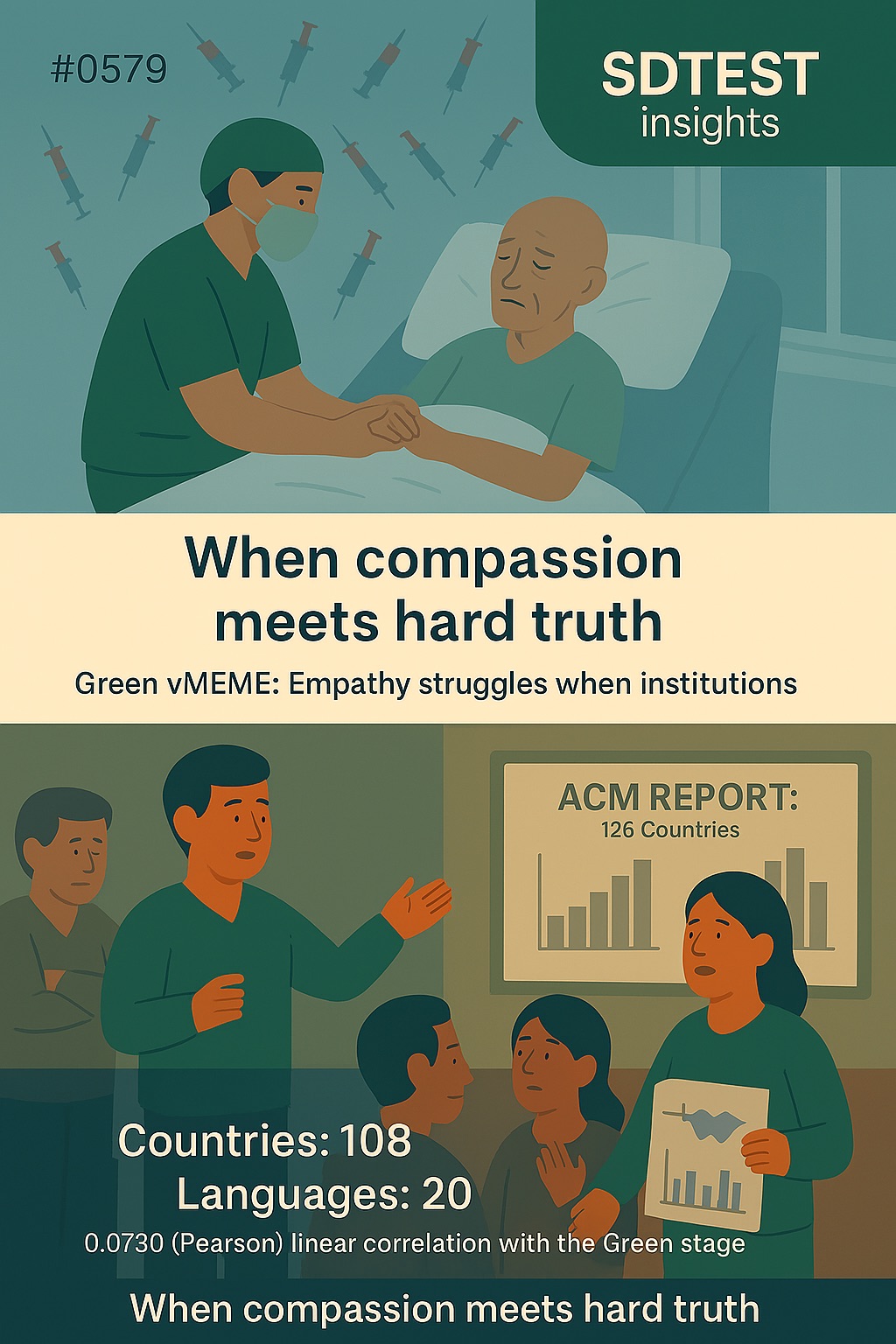
This positive correlation of 0.0730 between "Disease X (COVID-19)" and the Green stage offers profound insights when viewed through the lens of the Green value system:
Organizational Perspective:
Organizations operating within the Green mindset might interpret this correlation as:
- Validation of their holistic, interconnected worldview where pandemic diseases represent systemic threats to global community health and environmental sustainability
- Confirmation that their systems-thinking approach recognizes how infectious diseases expose and amplify existing social inequalities, ecological disruption, and collective vulnerability
- Evidence supporting their belief that pandemic responses require collaborative, community-centered solutions that prioritize collective well-being over individual or economic interests
These organizations might respond by:
- Implementing comprehensive pandemic preparedness programs that integrate public health, social justice, and environmental sustainability considerations
- Establishing inclusive decision-making processes that center marginalized communities, most vulnerable to disease impacts and systemic health inequities
- Creating regenerative business models that prioritize community resilience, worker safety, and collective healing over profit maximization during health crises
Team Perspective:
Teams operating from a Green mindset might approach this correlation by:
- Viewing it as an affirmation of their community-centered approach, where pandemic fears reflect deep concern for collective well-being and social interconnectedness
- Interpreting it as support for their belief that health crises disproportionately impact vulnerable populations and require collaborative, equity-focused responses
- Seeing it as validation for prioritizing mutual care, inclusive safety measures, and consensus-based health protocols that protect all team members
These teams might respond by:
- Developing compassionate pandemic response protocols that prioritize psychological safety, inclusive participation, and collective decision-making about health measures
- Implementing holistic wellness practices that address not only physical health but also mental, emotional, and spiritual impacts of disease fears
- Celebrating instances where team members demonstrate mutual care, solidarity with vulnerable populations, and commitment to collective health equity
Individual Perspective:
Individuals aligned with the Green value system might interpret this correlation as:
- Personal validation of their empathetic, community-oriented perspective, where pandemic fears stem from deep concern for global suffering and social injustice
- Evidence supporting their belief that infectious diseases represent interconnected threats to human and planetary health that require collective action
- Confirmation of the value they place on vulnerable populations and their understanding that health crises expose systemic inequalities requiring transformative change
These individuals might respond by:
- Actively engaging in community health advocacy, mutual aid networks, and solidarity actions that support those most impacted by pandemic effects
- Viewing their pandemic concerns as expressions of their commitment to social justice and their recognition of global interconnectedness
- Using their health awareness to promote systemic changes that address root causes of vulnerability, including environmental degradation and social inequality
This correlation, viewed through the Green lens, suggests that those operating at the Green level are more likely to identify Disease X (COVID-19) as one of their greatest fears. It implies that the Green value system's emphasis on community consciousness, systems thinking, and collective well-being creates heightened awareness of pandemic threats to global health equity.
The reasons why Disease X (COVID-19) might be considered one of the greatest fears in the Green stage could include:
- Collective Vulnerability: Recognition that pandemics expose how deeply interconnected human communities are and how individual health depends on collective well-being
- Social Justice Concerns: Understanding that infectious diseases disproportionately impact marginalized communities and exacerbate existing health inequities
- Systems Disruption: Awareness that pandemics threaten the social, economic, and environmental systems that support community resilience and sustainability
- Global Consciousness: Deep concern for suffering worldwide and recognition that health crises require collaborative, transnational responses
- Holistic Impact: Understanding that pandemics affect not just physical health but also the mental, emotional, spiritual, and ecological well-being of communities
This correlation prompts us to consider how different value systems influence fear responses and risk perception. It raises questions about the potential benefits of Green consciousness in pandemic preparedness, particularly in contexts where community health equity and holistic resilience are prioritized over individual or economic concerns.
Ultimately, this correlation highlights the complex interplay between community consciousness, systemic awareness, and health anxiety. Disease X (COVID-19) may be viewed not only as a personal health threat but also as a fundamental challenge to the values of equity, sustainability, and collective care that define Green-Dominated environments.
In our analysis of the poll "Characteristics of a talented employee" (by TMI [3]), we found an intriguing negative linear correlation that warrants closer examination:
-0.1360 (Pearson) between the Positive attitude and energy and the Yellow stage.
The critical value of the correlation coefficient for a normal distribution, by William Sealy Gosset (Student), is r = 0.1246. Nevertheless, this negative linear correlation of -0.1360 meets the reliability criteria but does not necessarily imply causation.
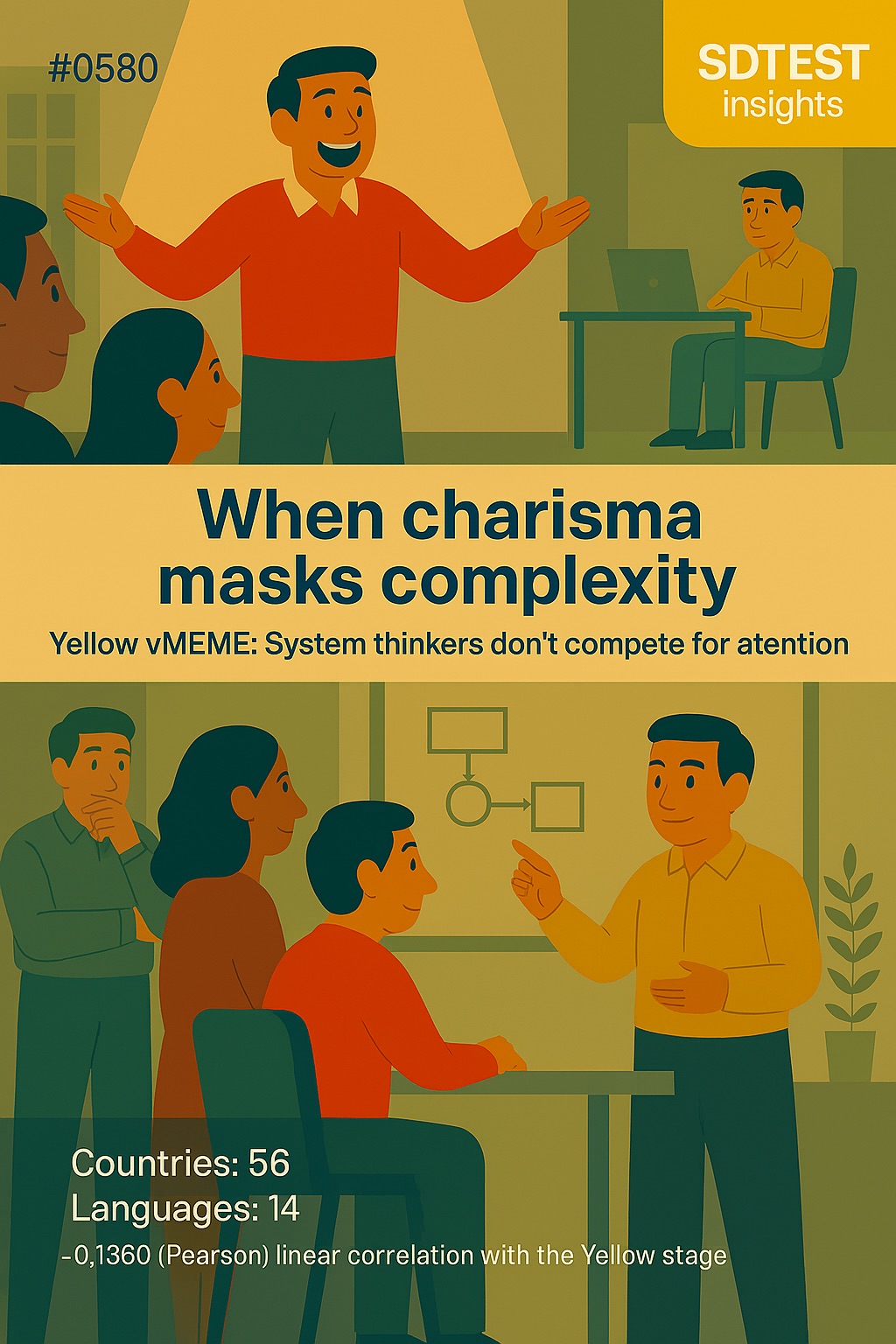
This negative correlation of -0.1360 between "Positive attitude and energy" and the Yellow stage offers profound insights when viewed through the lens of the Yellow value system:
Organizational Perspective:
Organizations operating within the Yellow mindset might interpret this correlation as:
- Validation of their integral complexity approach, where authentic talent transcends simplistic positive attitude requirements in favor of developmental sophistication and adaptive intelligence
- Confirmation that their meta-systemic organizational design recognizes that forced positivity represents lower-order thinking that cannot navigate the paradoxes and complexities of advanced problem-solving
- Evidence supporting their belief that truly talented employees operate with integral awareness that includes shadow integration, paradox tolerance, and the capacity to hold multiple emotional states simultaneously
These organizations might respond by:
- Implementing developmental assessment frameworks that evaluate cognitive complexity, perspective-taking ability, and meta-cognitive awareness rather than surface-level attitudinal metrics
- Establishing dynamic role structures that value authentic presence, integral thinking, and adaptive capacity over conventional enthusiasm or energy displays
- Creating learning ecosystems that honor the full spectrum of human experience, including doubt, skepticism, and critical analysis as essential components of advanced talent
Team Perspective:
Teams operating from a Yellow mindset might approach this correlation by:
- Viewing it as an affirmation of their spiral dynamics awareness and their recognition that authentic collaboration requires more than positive energy performance
- Interpreting it as support for their belief that high-functioning teams integrate diverse emotional and cognitive styles, including constructive criticism and realistic skepticism
- Seeing it as validation for prioritizing developmental maturity and integral consciousness over conventional team harmony based on artificial positivity
These teams might respond by:
- Developing sophisticated dialogue processes that welcome challenging perspectives, difficult emotions, and constructive conflict as essential to collective intelligence
- Implementing meta-learning protocols that value intellectual honesty, shadow work, and authentic presence over performed enthusiasm
- Celebrating instances where team members demonstrate developmental courage by expressing unpopular truths or challenging groupthink with integral awareness
Individual Perspective:
Individuals aligned with the Yellow value system might interpret this correlation as:
- Personal validation of their post-conventional development and their recognition that authentic talent includes the capacity for critical thinking and emotional complexity
- Evidence supporting their belief that forced positivity represents a developmental limitation that constrains integral awareness and adaptive intelligence
- Confirmation of the value they place on authentic presence and their understanding that true talent requires the ability to navigate paradox and complexity
These individuals might respond by:
- Actively cultivating practices that integrate all aspects of human experience, including doubt, criticism, and realistic assessment alongside genuine appreciation
- Viewing their resistance to artificial positivity as an indicator of their developmental sophistication and commitment to authentic expression
- Using their integral awareness to model emotionally mature responses that transcend simple positive/negative categorizations
This correlation, viewed through the Yellow lens, suggests that those operating at the Yellow level are less likely to view positive attitude and energy as essential characteristics of talented employees. It implies that the Yellow value system's emphasis on integral consciousness, developmental complexity, and meta-systemic thinking creates more sophisticated talent evaluation criteria.
The reasons why positive attitude and energy might not be seen as characteristics of talented employees in the Yellow stage could include:
- Integral Authenticity: True talent requires the capacity to hold multiple emotional states and express authentic responses rather than perform positivity
- Developmental Sophistication: Advanced employees demonstrate cognitive complexity that transcends simple attitudinal categories and embraces paradox
- Meta-Cognitive Awareness: Talented individuals recognize when a positive attitude might be inappropriate or when critical thinking requires challenging perspectives
- Shadow Integration: Integral development includes the capacity to work with difficult emotions and challenging realities as part of comprehensive talent development
- Adaptive Intelligence: Superior talent demonstrates flexibility across emotional and cognitive states rather than being constrained by positive attitude requirements
This correlation prompts us to consider how different developmental levels influence talent identification and employee evaluation criteria. It raises questions about the potential limitations of conventional positive attitude requirements when applied to highly developed individuals operating at integral consciousness levels, particularly in contexts where adaptive complexity and authentic presence are valued over surface-level enthusiasm.
Ultimately, this correlation highlights the complex interplay between developmental maturity, authentic expression, and talent evaluation. Positive attitude and energy might be seen not as irrelevant but as potentially constraining factors that limit the full expression of integral talent in Yellow-dominant environments.
In our analysis of the poll "Empathy is," we found an intriguing positive linear correlation that warrants closer examination:
0.1320 (Pearson) between the Feeling sorry for someone / Strongly Disagree and the Turquoise stage.
The critical value of the correlation coefficient for a normal distribution, by William Sealy Gosset (Student), is r = 0.0608. Nevertheless, this positive linear correlation of 0.1320 meets the reliability criteria but does not necessarily imply causation.
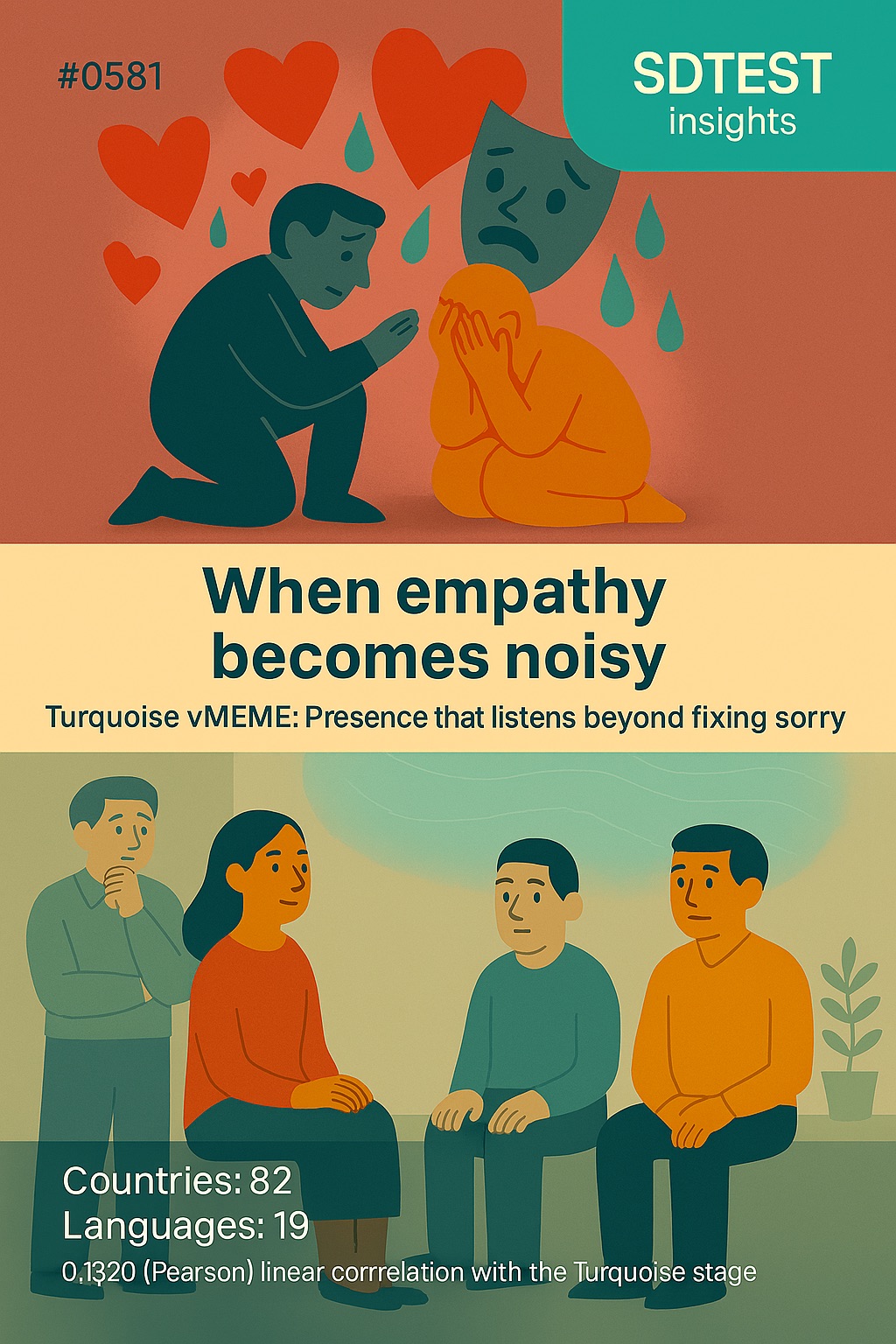
This positive correlation of 0.1320 between "Feeling sorry for someone / Strongly Disagree" and the Turquoise stage offers profound insights when viewed through the lens of the Turquoise value system:
Organizational Perspective:
Organizations operating within the Turquoise mindset might interpret this correlation as:
- Validation of their sacred activism approach, where empathy transcends pity to become a living systems intelligence that recognizes the inherent wholeness and divine essence within all beings
- Confirmation that their regenerative organizational design understands empathy as cosmic resonance that honors the interconnected web of consciousness rather than reducing it to condescending sympathy
- Evidence supporting their belief that authentic empathy involves witnessing and celebrating the evolutionary potential within each being rather than diminishing them through pity-based perspectives
These organizations might respond by:
- Implementing contemplative leadership practices that cultivate empathic presence as sacred recognition of universal consciousness expressing itself through diverse forms
- Establishing living systems governance that honors empathy as the capacity to perceive the divine light and evolutionary potential within all stakeholders
- Creating healing-centered organizational cultures where empathy serves as a bridge to collective awakening rather than reinforcing victim-savior dynamics
Team Perspective:
Teams operating from a Turquoise mindset might approach this correlation by:
- Viewing it as an affirmation of their integral ecology approach, where empathy becomes a doorway to recognizing the sacred interconnectedness and inherent wisdom within all team members
- Interpreting it as support for their belief that authentic empathy honors the soul's journey and evolutionary purpose rather than reducing individuals to objects of pity
- Seeing it as validation for prioritizing empathic witnessing and sacred reciprocity over condescending sympathy that reinforces separation and hierarchy
These teams might respond by:
- Developing contemplative practices that cultivate empathy as cosmic consciousness, recognizing itself in all forms, rather than emotional rescue dynamics
- Implementing circle processes that honor empathy as the capacity to witness and celebrate each being's unique expression of universal love
- Celebrating instances where empathic presence creates transformational healing by recognizing the divine wholeness rather than focusing on perceived deficits
Individual Perspective:
Individuals aligned with the Turquoise value system might interpret this correlation as:
- Personal validation of their evolutionary spirituality and their recognition that empathy is sacred communion with universal consciousness rather than pitying separate beings
- Evidence supporting their belief that authentic empathy involves recognizing the divine perfection and evolutionary wisdom within all experiences, including suffering
- Confirmation of the value they place on non-dual awareness and their understanding that feeling sorry reinforces the illusion of separation from the cosmic whole
These individuals might respond by:
- Actively cultivating contemplative practices that transform empathy into sacred recognition of the universal Self expressing through all forms
- Viewing their rejection of pity-based empathy as a commitment to honoring the divine sovereignty and evolutionary purpose within every being
- Using their integral consciousness to offer empathic presence that witnesses and celebrates the sacred journey rather than diminishing others through sympathy
This correlation, viewed through the Turquoise lens, suggests that those operating at the Turquoise level are more likely to strongly disagree that empathy means feeling sorry for someone else. It implies that the Turquoise value system's emphasis on cosmic consciousness, sacred interconnectedness, and evolutionary spirituality creates a fundamentally different understanding of empathic engagement.
The reasons why empathy would not be seen as feeling sorry for someone in the Turquoise stage could include:
- Sacred Recognition: Empathy becomes the capacity to recognize the divine essence and inherent wholeness within all beings, rather than pitying their apparent suffering
- Non-Dual Awareness: Understanding that separation is illusory; empathy involves recognizing oneself in all forms rather than sympathizing with separate others
- Evolutionary Perspective: Recognizing that all experiences, including challenges, serve the soul's evolution and cosmic awakening rather than being objects of pity
- Cosmic Consciousness: Empathy connects individuals to universal love and wisdom that transcends human sympathy and embraces divine compassion
- Sacred Reciprocity: Authentic empathy honors the mutual exchange of consciousness and wisdom rather than creating hierarchical rescue dynamics
This correlation prompts us to consider how different levels of consciousness influence our understanding of empathy and compassionate engagement. It raises questions about the potential for transforming sympathy-based helping into sacred recognition and evolutionary service, particularly in contexts where cosmic consciousness and planetary healing are recognized as fundamental to authentic empathy.
Ultimately, this correlation underscores the intricate interplay between spiritual development, empathic consciousness, and sacred relationships. Feeling sorry for someone might be seen not just as inadequate empathy but as a fundamental misunderstanding that reinforces separation and diminishes the divine wholeness inherent in all beings in Turquoise-dominant environments.
What insights do you gain from today's correlation? How might we study this relationship more carefully before deducing causation?
We welcome respectful and wise perspectives! Stay tuned every week as we share more results and insights.
After login or registration, free access to the poll results in the FAQ section.
[1] https://www.linkedin.com/in/jwmba
[2] https://www.linkedin.com/in/patrick-lencioni-orghealth
[3] https://www.linkedin.com/company/talent-management-institute
2025.08.03
FearpersonqualitiesprojectorganizationalstructureRACIresponsibilitymatrixCritical ChainProject Managementfocus factorJiraempathyleadersbossGermanyChinaPolicyUkraineRussiawarvolatilityuncertaintycomplexityambiguityVUCArelocatejobproblemcountryreasongive upobjectivekeyresultmathematicalpsychologyMBTIHR metricsstandardDEIcorrelationriskscoringmodelGame TheoryPrisoner's Dilemma
Valerii Kosenko
Umnikazi Womkhiqizo i-SaaS SDTEST®
U-Valerii waqeqeshelwa ukuba yisazi sezengqondo zezenhlalo ngo-1993 futhi usesebenzise ulwazi lwakhe ekuphathweni kwephrojekthi.
U-Valerii uthole iziqu ze-Master kanye neziqu zephrojekthi kanye nomphathi wohlelo ngo-2013. Phakathi nohlelo lwakhe lwe-Master, wajwayelana ne-Project Roadmap (GPM Deutsche Gesellschaft für Projektmanagement e. V.) kanye ne-Spiral Dynamics.
U-Valerii ungumbhali wokuhlola ukungaqiniseki kwe-V.U.C.A. umqondo usebenzisa iSpiral Dynamics kanye nezibalo zezibalo kupsychology, kanye namavoti angama-38 amazwe ngamazwe.
